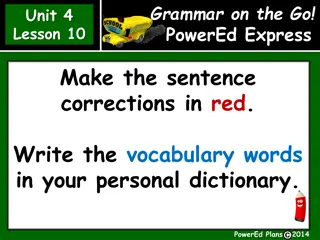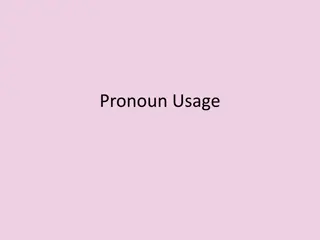PREPOSITIONS
A preposition is a word that establishes the relationship between a noun/pronoun and other words in a sentence. They convey direction, location, time, or manner. Prepositions are crucial for creating prepositional phrases, adding detail and clarity to sentences. Learn about common single-word prepos
2 views • 32 slides
Proper Use of Capital Letters in Writing
Understanding when to use capital letters is crucial in writing. This resource covers the rules for capitalizing names of people, places, days of the week, months, and the personal pronoun "I." It explains the importance of capitalizing proper nouns, starting sentences, and the usage of "I" with cap
5 views • 9 slides
Understanding Prepositions and Prepositional Phrases
Prepositions are words that connect nouns or pronouns to other words in a sentence, indicating time or direction. Prepositional phrases include a preposition, its object (a noun or pronoun), and modifiers for that object. They act as adverbs, describing when, where, or how things happen. Examples an
0 views • 7 slides
Pronoun Placement with Commands in English and Spanish
Understanding pronoun placement in commands is crucial in both English and Spanish. In English, pronouns are placed after the verb in both affirmative and negative commands. However, in Spanish, affirmatives attach pronouns while negatives place them in front of the verb. Examples and accent rules a
1 views • 5 slides
Pronoun Placement Rules in Spanish Sentences
Clear up confusion around the placement of reflexive, direct object, and indirect object pronouns in Spanish sentences and commands. Learn the placement rules for different types of pronouns in statements and commands, including examples for single-verb and two-verb sentences. Understand the order o
2 views • 10 slides
Understanding English Imperative Sentences
English imperative sentences function as directives or commands, characterized by having no overt subject noun phrase, using an implicit second-person pronoun (you) as the subject, being tenseless with the base form of the verb, always indicating future actions, and not occurring in subordinate clau
1 views • 22 slides
Understanding Adjective Clauses in English Grammar
Adjective clauses, also known as relative clauses, are dependent clauses that act as adjectives in sentences. They modify nouns, pronouns, or entire sentences and begin with a relative pronoun. This article explains how adjective clauses function, provides examples, and discusses the use of pronouns
1 views • 62 slides
Understanding Pronoun Reference and Antecedent Agreement
Discover the essentials of pronouns, antecedents, and their agreement in this informative content. Learn about pronoun usage, types of errors that can occur, and how to correct them. Enhance your grammar skills to ensure clear and effective communication.
3 views • 17 slides
Promoting Equality & Diversity at Fortrose Academy: Happy, Healthy Highlanders
Fraser Thomson, an assistant Youth Worker, introduces the efforts of the Equality and Diversity Steering Group at Fortrose Academy. Lua, Dominic, and Ethan, along with other members, share the group's goals of fostering inclusivity, raising awareness, and supporting minority groups. Through initiati
0 views • 8 slides
Understanding Complements in Grammar
The word "complement" originates from Latin meaning to fill up or complete and is essential in completing the meaning of a verb. Complements can be a noun, pronoun, or adjective but never an adverb. They are never found in a prepositional phrase. Learn about direct objects, indirect objects, and pre
0 views • 15 slides
Mastering Tag Questions in English Grammar
Learn how to effectively construct and use tag questions in English grammar through four basic rules: ensuring same tense, using negative tags for affirmative sentences and vice versa, always including a pronoun, and using contracted forms of helping verbs in negative tags. Examples provided for bet
0 views • 25 slides
Understanding Pronouns: Cases, Perspectives, and Usage
Explore the nuances of pronouns including cases, perspectives, and correct usage to enhance your language skills. Learn about subjective, objective, and reflexive pronouns, as well as how to choose the right pronoun based on the context. Enhance your command of standard English grammar and usage wit
0 views • 15 slides
College Writing Workshop: Improve Your Grammar and Punctuation Skills
Enhance your writing proficiency by addressing common errors such as comma usage, pronoun agreement, and vague pronoun reference. Understand the impact of mistakes on how readers perceive your communication. Elevate your knowledge of writing rules to convey a professional image effectively.
0 views • 14 slides
Grammar Correction and Writing Skills with PowerEd Express
Improve your grammar and writing skills with PowerEd Express by correcting sentences, learning vocabulary words, and understanding grammar concepts such as capitalization, apostrophes, run-on sentences, and vague pronoun references. Enhance your sentence structure and clarity through interactive les
0 views • 11 slides
Understanding Inversion in English Grammar
Inversion in English grammar refers to the reversal of the usual word order of a subject and a verb in a sentence. This reversal often occurs when starting a sentence with an adverb or adverbial phrase of place, creating a more dramatic effect. Inversion is also seen in direct speech, where the subj
0 views • 11 slides
Correcting Grammatical Errors - Bellwork Activities 8
Practice correcting grammatical errors in sentences with these Bellwork activities. Identify and fix errors in each sentence provided along with the learning goal for each task. Improve your grammar skills by correcting errors related to subject-verb agreement, pronoun usage, punctuation, and more.
0 views • 11 slides
Cross-Linguistic Influence on L2 Acquisition of Dutch Quantitative Pronoun "ER
This study examines the L2 acquisition of the Dutch quantitative pronoun "ER" by L1 French and L1 English adults. It explores the syntax and semantics of using "ER" with quantifiers in Dutch, French, and English, analyzing potential cross-linguistic influences on sentence acceptance. The research hi
0 views • 22 slides
Mastering Capitalization Rules: Proper Nouns, Titles, and More
Learn the ins and outs of capitalization rules, from when to capitalize proper nouns, titles, and headings to the first word in a sentence and the pronoun "I." Explore examples and quick practice exercises to enhance your understanding of capitalization conventions.
0 views • 15 slides
Mastering Pronouns: A Comprehensive Guide
Understand the nuances of pronoun usage with this detailed guide, covering pronoun cases, usage in questions and clauses, compound structures, elliptical constructions, pronoun-antecedent agreement, and more. Enhance your writing skills by mastering pronoun rules and applications.
0 views • 10 slides
Understanding Pronoun Case: Nominative and Objective Pronouns
We have covered all pronouns in the slide show but still need to discuss pronoun case. Personal pronouns have nominative and objective cases. Nominative pronouns like "I" are used as subjects, while objective pronouns like "me" are used as objects. Learn how to use them correctly in sentences with e
0 views • 11 slides
Pronoun Usage in College Syllabi: Impact and Controversy
The recommended syllabus at Williamson College of Business sparked debate over the inclusion of pronouns, with concerns raised about discomfort and fear among students. The documentation suggests that the syllabus is a draft and not mandatory, leading to questions about its official status and align
0 views • 6 slides
Understanding Pronoun and Antecedent Agreement
Learn about the agreement between pronouns and their antecedents, including rules for singular and plural pronouns, gender-specific pronouns, indefinite pronouns, and compound antecedents. Ensure proper alignment to avoid grammatical errors.
0 views • 9 slides
Understanding Pronouns: Usage and Agreement
Pronouns play a vital role in substituting nouns to enhance clarity and avoid repetition. However, ensuring clear reference to antecedents is crucial to prevent confusion among readers. This guide explores the importance of pronoun usage, common pitfalls, and strategies for maintaining clarity in wr
0 views • 6 slides
Mastering Spelling and Grammar: A Comprehensive Guide
Enhance your writing skills by mastering spelling, grammar, and pronoun usage with practical examples. Understand how pronouns relate to antecedents and ensure agreement in number and gender. Improve clarity and coherence in your writing by following essential rules and principles.
0 views • 49 slides
Understanding Grammatical Errors Caused by Mother-Tongue Interference in English Learners
Young English learners face challenges in language acquisition, resulting in various grammatical errors influenced by their native language. Analyzing these errors can aid in developing effective teaching strategies. The study explores errors like incorrect auxiliary verb usage and pronoun confusion
0 views • 14 slides
Effective Use of "You" in Writing: Informal vs. Formal Guidelines
Understanding the usage of the second-person pronoun "you" in writing is essential for clear communication. In informal settings, "you" is used broadly to address readers directly or as an indefinite pronoun. However, in formal writing, it's crucial to avoid potential reader bias by using alternativ
0 views • 4 slides
Sharing Favorite Films and Relative Pronoun Practice
In this conversation, we discuss favorite films, focusing on "The History Boys," and invite you to share your favorite film with details like its title, why you like it, who stars in it, and what it's about. Additionally, there is a practice session on using relative pronouns in defining and non-def
0 views • 12 slides
Reflexives as Movement Diagnostic Under Ellipsis in English
Explore the syntax of ellipsis in English focusing on gapping, stripping, sluicing, and more. Understand reflexives as a movement diagnostic under ellipsis, examining scenarios where reflexives must have a c-commanding clausemate binder. Dive into experiments evaluating the plausibility of pronoun r
0 views • 20 slides
Comprehensive Peer Editing Strategies for AP Language and Composition
Engage in a structured peer editing process for an AP Language and Composition essay within 60 minutes. Tasks include MLA formatting, title evaluation, attention getter analysis, thesis and preview review, error identification, and pronoun assessment.
0 views • 38 slides
Evolution of Gender-Neutral Pronouns in English: Singular "They
The text discusses the evolution of using gender-neutral pronouns in English, particularly focusing on the acceptance and adoption of singular "they." It highlights the historical resistance, societal shifts, and linguistic authority approvals that have led to the emergence of "they" as a gender-neu
0 views • 11 slides
Understanding Verbs: Types and Usage
Verbs are essential in forming statements and expressing action or states of being. They can show time through different tenses such as past, present, and future. Action verbs depict physical or mental actions, while linking verbs connect the subject with a noun, pronoun, or adjective. Verb phrases
0 views • 8 slides
Mastering Pronoun Case: Essential Tips and Tricks
Learn about the four cases of pronouns in English - subjective, objective, reflexive, and possessive. Discover six essential tips and tricks to handle pronoun usage effectively, from using "who" and "whom" correctly to understanding when to remove or substitute information. Improve your grammar skil
0 views • 10 slides
Understanding Grammar Terms in Business Translation (ENB4202)
Explore key grammar terms such as action verb, adjective, adverb, article, clause, coordinating conjunction, dependent clause, gerund, linking verb, noun, noun phrase, object, phrase, preposition, pronoun, and subject in the context of business translation. Learn their definitions, functions, and ex
0 views • 14 slides
Mastering Relative Clauses in Writing
Enhance your writing skills by mastering the use of relative clauses to draw inferences about characters' feelings, thoughts, and motives. Learn how to add extra information to sentences using relative clauses beginning with who, which, where, when, whose, that, or an omitted relative pronoun. Explo
0 views • 20 slides
Exploring the Use of Pronouns in Fiction Writing
Investigate how authors withhold information about characters using pronouns in fiction. Analyze examples from novels like Skellig and The Bourne Imperative to understand the impact of pronoun choice on reader engagement and character development.
1 views • 10 slides
Understanding Adjectives in English Grammar
An adjective is a word that describes, identifies, modifies, or quantifies a noun or pronoun. Learn about descriptive, demonstrative, possessive, and quantifying adjectives along with examples. Understand the placement of adjectives in sentences and differentiate between proper and common adjectives
0 views • 23 slides
Understanding Motivation for Change in Essay Writing
The essay discusses the importance of change and motivation, emphasizing the internal drive for change. It explores the risks and benefits associated with embracing change versus staying stagnant, highlighting that motivation for change comes from within. The prompts typically revolve around respond
0 views • 19 slides
Language Learning Resources Overview
Explore a variety of language learning resources including chant sessions, songs, pronoun lessons, and alphabet reviews. Enhance your vocabulary and pronunciation skills in a fun and interactive way. From adjectives to nouns, this collection covers essential language basics to help you develop profi
0 views • 25 slides
Mastering Relative Pronouns: A Comprehensive Guide
Dive into the world of relative pronouns with this comprehensive guide featuring explanations and examples of using who, whoever, whom, whomever, whose, which, that, and this. Explore how to choose the right relative pronoun for people, places, and things, and learn about their usage in restrictive
0 views • 5 slides
Mastering Active and Passive Voice Conversions
Explore the nuances of active and passive voice transformations with practical examples and guidelines. Learn how to convert sentences from active to passive voice efficiently using general rules, tense identification, pronoun changes, and more. Enhance your writing skills and understand when to eff
0 views • 11 slides







































